Marriage and Family 1 Learning Objectives 2

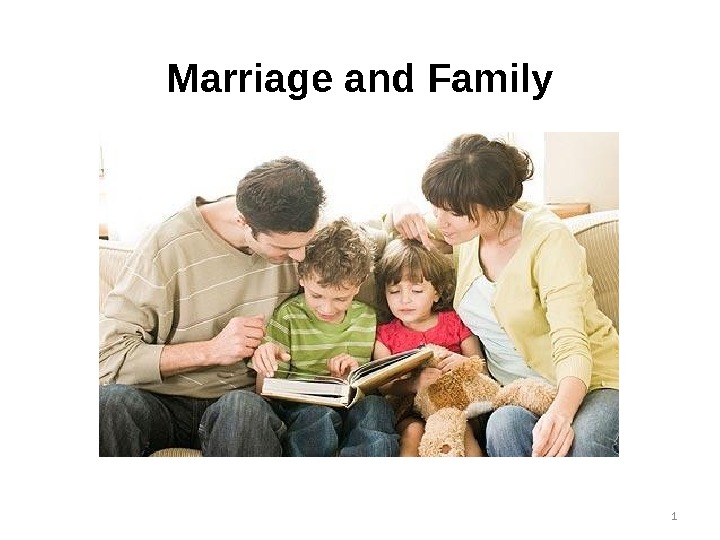
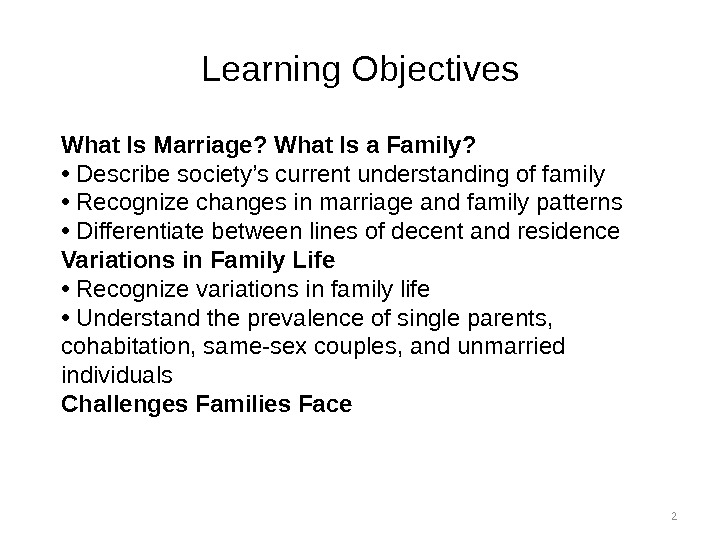
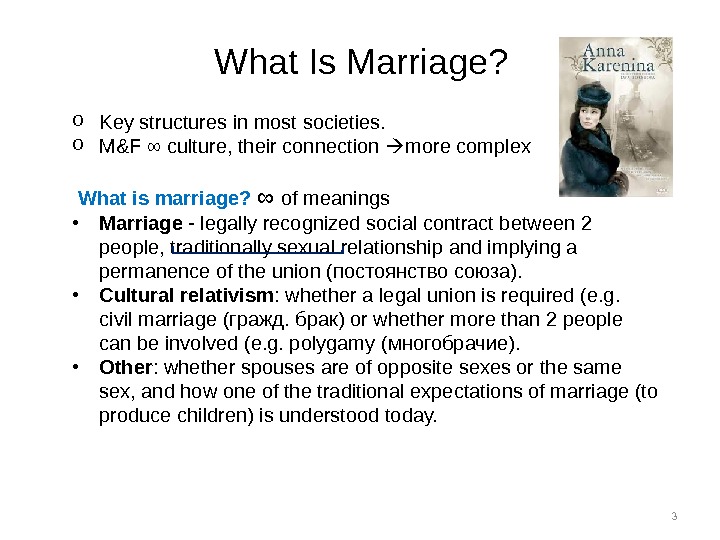
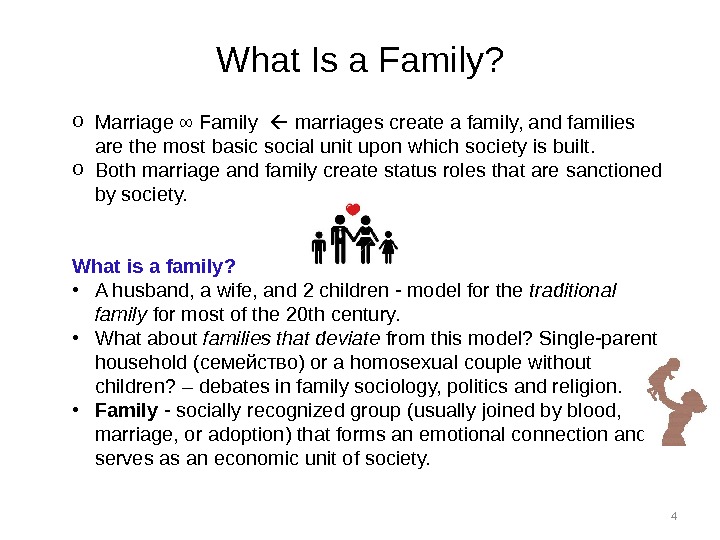
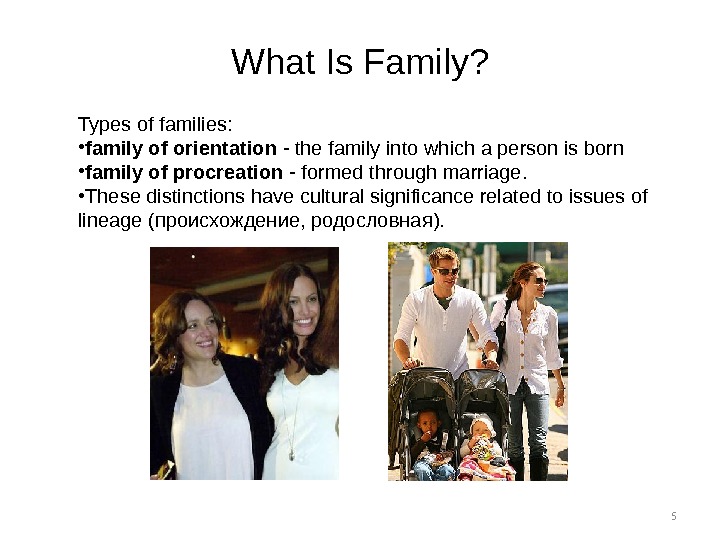
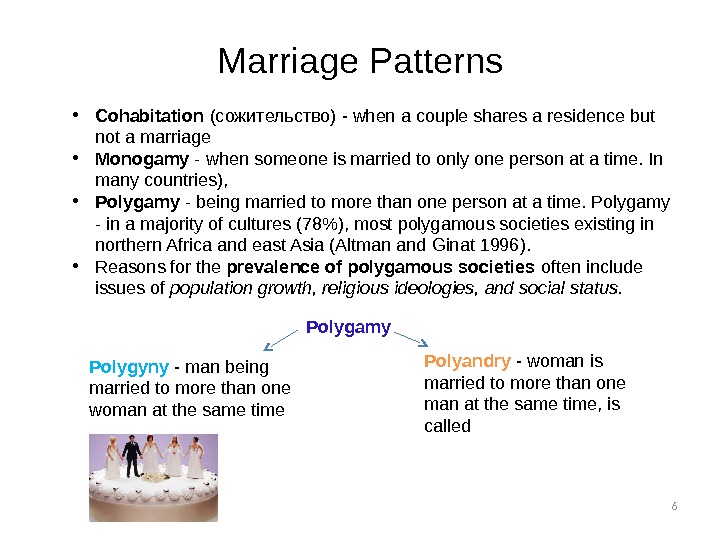
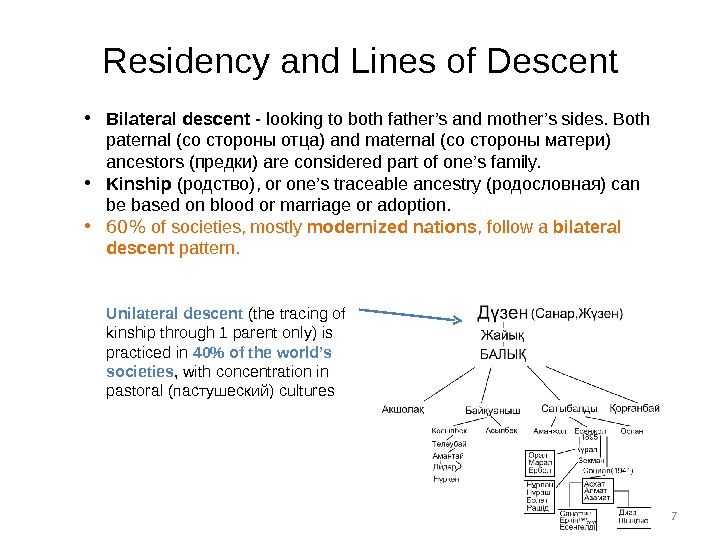
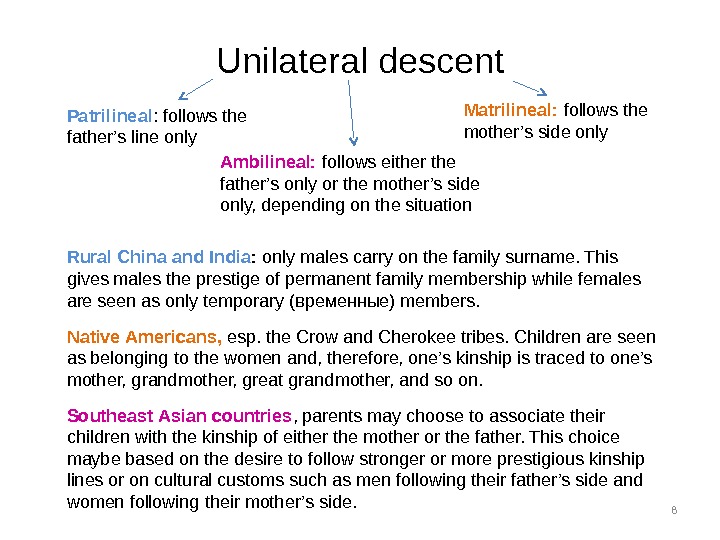
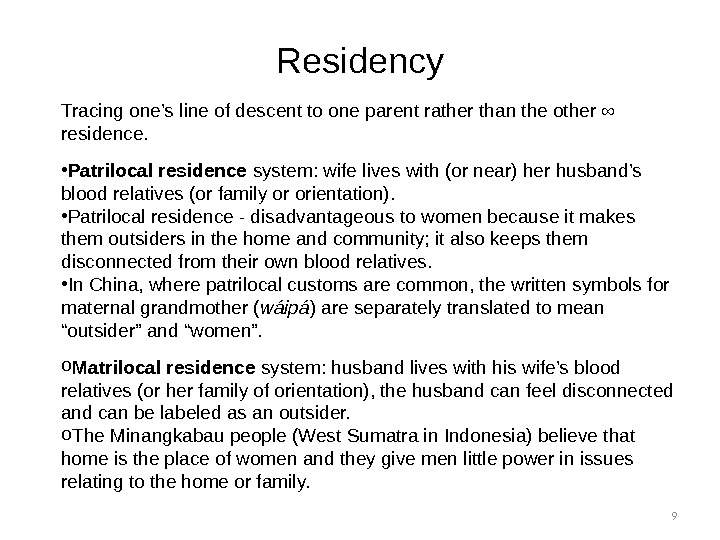
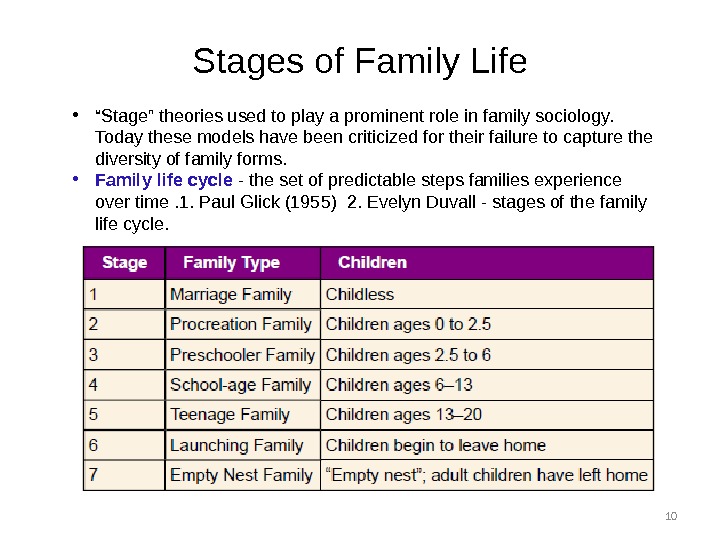
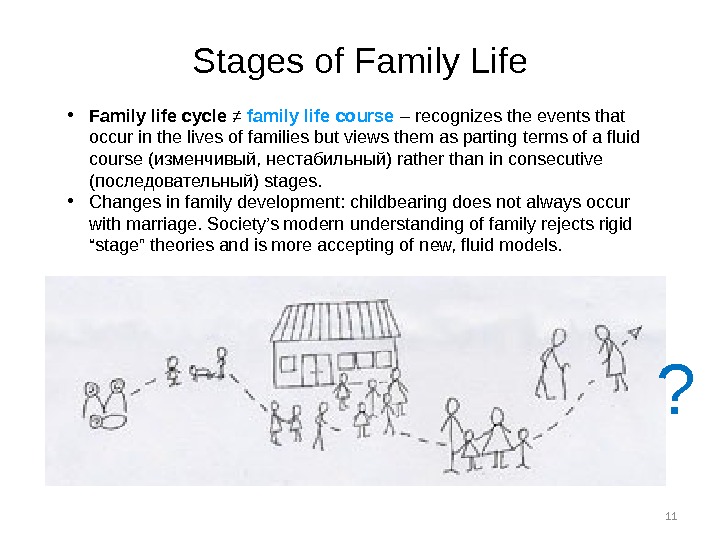
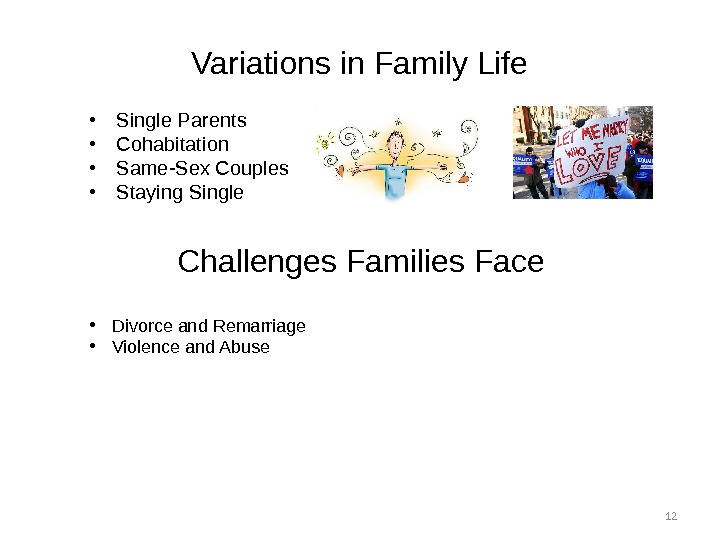
- Размер: 540.5 Кб
- Количество слайдов: 12
Описание презентации Marriage and Family 1 Learning Objectives 2 по слайдам
 Marriage and Family
Marriage and Family
 Learning Objectives 2 What Is Marriage? What Is a Family? • Describe society’s current understanding of family • Recognize changes in marriage and family patterns • Differentiate between lines of decent and residence Variations in Family Life • Recognize variations in family life • Understand the prevalence of single parents, cohabitation, same-sex couples, and unmarried individuals Challenges Families Face
Learning Objectives 2 What Is Marriage? What Is a Family? • Describe society’s current understanding of family • Recognize changes in marriage and family patterns • Differentiate between lines of decent and residence Variations in Family Life • Recognize variations in family life • Understand the prevalence of single parents, cohabitation, same-sex couples, and unmarried individuals Challenges Families Face
 3 What Is Marriage? o Key structures in most societies. o M&F ∞ culture, their connection more complex What is marriage? ∞ of meanings • Marriage — legally recognized social contract between 2 people, traditionally sexual relationship and implying a permanence of the union ( постоянство союза ). • С ultural relativism : whether a legal union is required (e. g. civil marriage (гражд. брак ) or whether more than 2 people can be involved (e. g. polygamy ( многобрачие ). • Other : whether spouses are of opposite sexes or the same sex, and how one of the traditional expectations of marriage (to produce children) is understood today.
3 What Is Marriage? o Key structures in most societies. o M&F ∞ culture, their connection more complex What is marriage? ∞ of meanings • Marriage — legally recognized social contract between 2 people, traditionally sexual relationship and implying a permanence of the union ( постоянство союза ). • С ultural relativism : whether a legal union is required (e. g. civil marriage (гражд. брак ) or whether more than 2 people can be involved (e. g. polygamy ( многобрачие ). • Other : whether spouses are of opposite sexes or the same sex, and how one of the traditional expectations of marriage (to produce children) is understood today.
 4 What Is a Family? o Marriage ∞ Family marriages create a family, and families are the most basic social unit upon which society is built. o Both marriage and family create status roles that are sanctioned by society. What is a family? • A husband, a wife, and 2 children — model for the traditional family for most of the 20 th century. • What about families that deviate from this model? Single-parent household ( семейство ) or a homosexual couple without children? – debates in family sociology, politics and religion. • Family — socially recognized group (usually joined by blood, marriage, or adoption) that forms an emotional connection and serves as an economic unit of society.
4 What Is a Family? o Marriage ∞ Family marriages create a family, and families are the most basic social unit upon which society is built. o Both marriage and family create status roles that are sanctioned by society. What is a family? • A husband, a wife, and 2 children — model for the traditional family for most of the 20 th century. • What about families that deviate from this model? Single-parent household ( семейство ) or a homosexual couple without children? – debates in family sociology, politics and religion. • Family — socially recognized group (usually joined by blood, marriage, or adoption) that forms an emotional connection and serves as an economic unit of society.
 5 What Is Family? Types of families: • family of orientation — the family into which a person is born • family of procreation — formed through marriage. • These distinctions have cultural significance related to issues of lineage ( происхождение, родословная ).
5 What Is Family? Types of families: • family of orientation — the family into which a person is born • family of procreation — formed through marriage. • These distinctions have cultural significance related to issues of lineage ( происхождение, родословная ).
 6 Marriage Patterns • С ohabitation (сожительство) — when a couple shares a residence but not a marriage • Monogamy — when someone is married to only one person at a time. In many countries), • Polygamy — being married to more than one person at a time. Polygamy — in a majority of cultures (78%), most polygamous societies existing in northern Africa and east Asia (Altman and Ginat 1996). • Reasons for the prevalence of polygamous societies often include issues of population growth, religious ideologies, and social status. Polygamy Polygyny — man being married to more than one woman at the same time Polyandry — woman is married to more than one man at the same time, is called
6 Marriage Patterns • С ohabitation (сожительство) — when a couple shares a residence but not a marriage • Monogamy — when someone is married to only one person at a time. In many countries), • Polygamy — being married to more than one person at a time. Polygamy — in a majority of cultures (78%), most polygamous societies existing in northern Africa and east Asia (Altman and Ginat 1996). • Reasons for the prevalence of polygamous societies often include issues of population growth, religious ideologies, and social status. Polygamy Polygyny — man being married to more than one woman at the same time Polyandry — woman is married to more than one man at the same time, is called
 7 Residency and Lines of Descent • Bilateral descent — looking to both father’s and mother’s sides. Both paternal ( со стороны отца ) and maternal (со стороны матери) ancestors (предки) are considered part of one’s family. • Kinship (родство) , or one’s traceable ancestry (родословная) can be based on blood or marriage or adoption. • 60% of societies, mostly modernized nations , follow a bilateral descent pattern. Unilateral descent (the tracing of kinship through 1 parent only) is practiced in 4 0% of the world’s societies , with concentration in pastoral (пастушеский) cultures
7 Residency and Lines of Descent • Bilateral descent — looking to both father’s and mother’s sides. Both paternal ( со стороны отца ) and maternal (со стороны матери) ancestors (предки) are considered part of one’s family. • Kinship (родство) , or one’s traceable ancestry (родословная) can be based on blood or marriage or adoption. • 60% of societies, mostly modernized nations , follow a bilateral descent pattern. Unilateral descent (the tracing of kinship through 1 parent only) is practiced in 4 0% of the world’s societies , with concentration in pastoral (пастушеский) cultures
 8 Unilateral descent Patrilineal : follows the father’s line only Matrilineal: follows the mother’s side only Ambilineal: follows either the father’s only or the mother’s side only, depending on the situation Rural China and India : only males carry on the family surname. This gives males the prestige of permanent family membership while females are seen as only temporary ( временные ) members. Native Americans, esp. the Crow and Cherokee tribes. Children are seen as belonging to the women and, therefore, one’s kinship is traced to one’s mother, grandmother, great grandmother, and so on. Southeast Asian countries , parents may choose to associate their children with the kinship of either the mother or the father. This choice maybe based on the desire to follow stronger or more prestigious kinship lines or on cultural customs such as men following their father’s side and women following their mother’s side.
8 Unilateral descent Patrilineal : follows the father’s line only Matrilineal: follows the mother’s side only Ambilineal: follows either the father’s only or the mother’s side only, depending on the situation Rural China and India : only males carry on the family surname. This gives males the prestige of permanent family membership while females are seen as only temporary ( временные ) members. Native Americans, esp. the Crow and Cherokee tribes. Children are seen as belonging to the women and, therefore, one’s kinship is traced to one’s mother, grandmother, great grandmother, and so on. Southeast Asian countries , parents may choose to associate their children with the kinship of either the mother or the father. This choice maybe based on the desire to follow stronger or more prestigious kinship lines or on cultural customs such as men following their father’s side and women following their mother’s side.
 9 Tracing one’s line of descent to one parent rather than the other ∞ residence. • Patrilocal residence system: wife lives with (or near) her husband’s blood relatives (or family or orientation). • Patrilocal residence — disadvantageous to women because it makes them outsiders in the home and community; it also keeps them disconnected from their own blood relatives. • In China, where patrilocal customs are common, the written symbols for maternal grandmother ( wáipá ) are separately translated to mean “outsider” and “women”. o Matrilocal residence system: husband lives with his wife’s blood relatives (or her family of orientation), the husband can feel disconnected and can be labeled as an outsider. o The Minangkabau people (West Sumatra in Indonesia) believe that home is the place of women and they give men little power in issues relating to the home or family. Residency
9 Tracing one’s line of descent to one parent rather than the other ∞ residence. • Patrilocal residence system: wife lives with (or near) her husband’s blood relatives (or family or orientation). • Patrilocal residence — disadvantageous to women because it makes them outsiders in the home and community; it also keeps them disconnected from their own blood relatives. • In China, where patrilocal customs are common, the written symbols for maternal grandmother ( wáipá ) are separately translated to mean “outsider” and “women”. o Matrilocal residence system: husband lives with his wife’s blood relatives (or her family of orientation), the husband can feel disconnected and can be labeled as an outsider. o The Minangkabau people (West Sumatra in Indonesia) believe that home is the place of women and they give men little power in issues relating to the home or family. Residency
 10 Stages of Family Life • “ Stage” theories used to play a prominent role in family sociology. Today these models have been criticized for their failure to capture the diversity of family forms. • Family life cycle — the set of predictable steps families experience over time. 1. Paul Glick (1955) 2. Evelyn Duvall — stages of the family life cycle.
10 Stages of Family Life • “ Stage” theories used to play a prominent role in family sociology. Today these models have been criticized for their failure to capture the diversity of family forms. • Family life cycle — the set of predictable steps families experience over time. 1. Paul Glick (1955) 2. Evelyn Duvall — stages of the family life cycle.
 11 • Family life cycle ≠ family life course – recognizes the events that occur in the lives of families but views them as parting terms of a fluid course ( изменчивый, нестабильный ) rather than in consecutive (последовательный) stages. • С hanges in family development: childbearing does not always occur with marriage. Society’s modern understanding of family rejects rigid “stage” theories and is more accepting of new, fluid models. Stages of Family Life ?
11 • Family life cycle ≠ family life course – recognizes the events that occur in the lives of families but views them as parting terms of a fluid course ( изменчивый, нестабильный ) rather than in consecutive (последовательный) stages. • С hanges in family development: childbearing does not always occur with marriage. Society’s modern understanding of family rejects rigid “stage” theories and is more accepting of new, fluid models. Stages of Family Life ?
 12 Variations in Family Life • Single Parents • Cohabitation • Same-Sex Couples • Staying Single Challenges Families Face • Divorce and Remarriage • Violence and Abuse
12 Variations in Family Life • Single Parents • Cohabitation • Same-Sex Couples • Staying Single Challenges Families Face • Divorce and Remarriage • Violence and Abuse

